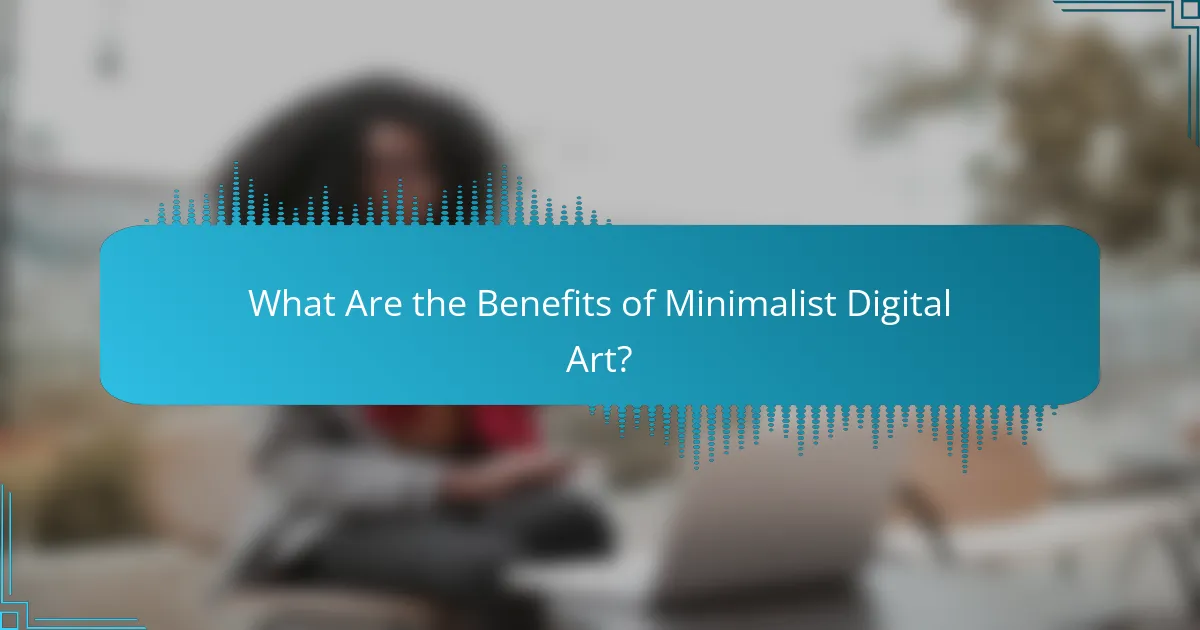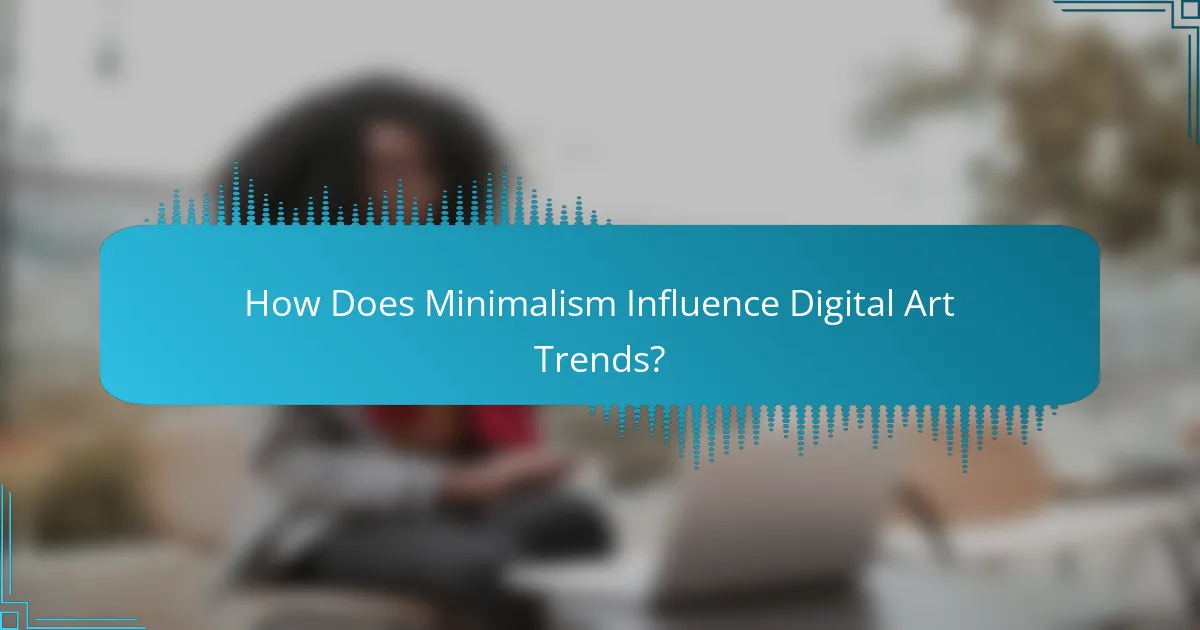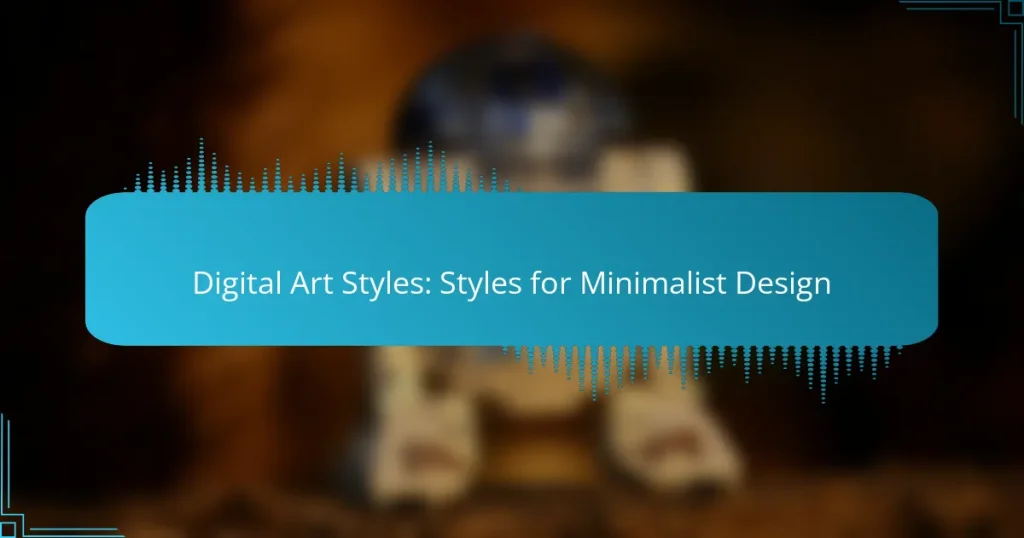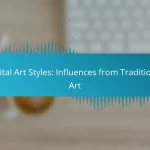Digital art styles for minimalist design prioritize simplicity and clarity, stripping away unnecessary details to focus on essential elements. By understanding your brand’s essence and aligning it with audience expectations, you can create impactful compositions that resonate with viewers. Utilizing tools like Adobe Illustrator, Procreate, and Canva can further enhance your ability to achieve a clean and functional aesthetic.

What Are the Best Digital Art Styles for Minimalist Design?
The best digital art styles for minimalist design emphasize simplicity and clarity, focusing on essential elements while eliminating unnecessary details. These styles create visually appealing compositions that convey messages effectively without overwhelming the viewer.
Flat Design
Flat design is characterized by its use of two-dimensional elements and bright colors without any gradients or textures. This style promotes a clean and straightforward aesthetic, making it ideal for minimalist projects. Key considerations include using bold typography and simple icons to enhance usability.
When implementing flat design, avoid excessive embellishments and stick to a limited color palette. This approach helps maintain focus on the content and improves user experience across digital platforms.
Line Art
Line art utilizes simple lines to create shapes and forms, often without any fill or shading. This style is effective in minimalist design as it conveys ideas with clarity and elegance. Line art can be used for illustrations, logos, and icons, making it versatile for various applications.
To achieve a successful line art design, ensure that the lines are consistent in thickness and maintain a cohesive style throughout the piece. Combining line art with ample white space can enhance its impact and readability.
Geometric Shapes
Geometric shapes focus on basic forms like circles, squares, and triangles to create visually striking compositions. This style is effective in minimalist design as it simplifies complex ideas into recognizable symbols. Geometric patterns can add structure and rhythm to a design while remaining visually appealing.
When using geometric shapes, consider balancing them with negative space to avoid clutter. Experimenting with different arrangements can lead to unique designs that still adhere to minimalist principles.
Monochromatic Color Schemes
Monochromatic color schemes involve using variations of a single color, creating a harmonious and cohesive look. This style is particularly effective in minimalist design as it reduces visual noise and emphasizes form and composition. A well-chosen monochromatic palette can evoke specific emotions and enhance the overall aesthetic.
To implement this style, select a base color and explore its lighter and darker shades. This approach allows for depth and contrast while keeping the design unified and simple.
Negative Space Usage
Negative space, or white space, refers to the empty areas around and between elements in a design. Effective use of negative space is crucial in minimalist design, as it helps to highlight important content and create a sense of balance. This technique can lead to more engaging and visually appealing compositions.
When designing with negative space, aim for a balance between filled and empty areas. Avoid overcrowding elements and allow for breathing room, which can enhance the viewer’s focus and understanding of the design.

How to Choose a Minimalist Art Style?
Choosing a minimalist art style involves understanding your brand’s essence and aligning it with audience expectations. Focus on simplicity, functionality, and visual clarity to create an impactful design that resonates with viewers.
Identify Your Brand Identity
Your brand identity is the foundation for selecting a minimalist art style. Consider your brand’s values, mission, and personality. For instance, a tech company may opt for sleek, geometric designs, while a wellness brand might prefer softer, organic shapes.
Develop a mood board that reflects your brand’s aesthetic. Include colors, shapes, and typography that align with your identity. This visual reference will guide your design choices and ensure consistency across all platforms.
Consider Audience Preferences
Understanding your audience is crucial when choosing a minimalist art style. Research their preferences, demographics, and cultural influences. For example, younger audiences may favor bold colors and modern designs, while older demographics might appreciate more subdued tones and classic forms.
Engage with your audience through surveys or social media polls to gather insights. This feedback can help refine your design approach and ensure it resonates with your target market.
Evaluate Visual Impact
Assess the visual impact of your chosen minimalist art style by considering clarity and emotional resonance. A successful minimalist design should convey your message quickly and effectively, avoiding clutter that can distract viewers.
Test different designs with focus groups or A/B testing to gauge reactions. Look for styles that evoke the desired emotions while maintaining simplicity. Remember, the goal is to create a memorable impression without overwhelming the audience.

What Tools Are Best for Creating Minimalist Digital Art?
To create minimalist digital art, tools that emphasize simplicity and precision are essential. Popular options include Adobe Illustrator, Procreate, Canva, and Affinity Designer, each offering unique features suited for minimalist design.
Adobe Illustrator
Adobe Illustrator is a vector graphics editor widely used for creating clean, scalable designs. Its precision tools allow artists to create sharp lines and shapes, which are crucial for minimalist aesthetics.
Consider using the Pen tool for custom shapes and the Shape Builder tool for combining elements seamlessly. Illustrator’s extensive library of fonts and colors can help maintain a minimalist palette while ensuring clarity and impact.
Procreate
Procreate is a powerful digital painting app favored by illustrators for its intuitive interface and versatility. It allows for freehand drawing, making it ideal for creating minimalist art with a personal touch.
Utilize Procreate’s brush customization to achieve clean lines and simple textures. The app supports layering, which can help in organizing elements without cluttering the design, a key principle in minimalism.
Canva
Canva is a user-friendly graphic design tool that simplifies the creation of minimalist art, especially for those without extensive design skills. It offers a wide range of templates and design elements that can be easily customized.
Focus on using white space effectively and limit your color palette to enhance simplicity. Canva’s drag-and-drop functionality allows for quick adjustments, making it easy to experiment with different layouts while adhering to minimalist principles.
Affinity Designer
Affinity Designer is a cost-effective alternative to Adobe Illustrator, providing robust vector and raster design capabilities. It is well-suited for creating minimalist designs due to its precision and flexibility.
Take advantage of its grid and snapping features to align elements perfectly. Affinity Designer also allows for real-time performance, which is beneficial for artists looking to refine their minimalist compositions efficiently.

What Are the Benefits of Minimalist Digital Art?
Minimalist digital art offers several advantages, including a clearer focus on essential elements, enhanced user engagement, and quicker loading times. By stripping away unnecessary details, this style allows viewers to appreciate the core message and visual appeal more effectively.
Enhanced Focus on Content
Minimalist design emphasizes simplicity, which directs attention to the most important content. By using fewer elements, artists can create a stronger impact with their visuals, ensuring that the message is not lost in clutter. This approach is particularly effective in digital platforms where users often skim through information quickly.
For instance, a minimalist website might feature ample white space and a limited color palette, allowing key images or text to stand out. This technique can significantly improve viewer retention and understanding of the content presented.
Improved User Experience
A minimalist approach often leads to a more intuitive user experience. By reducing visual noise, users can navigate through content more easily, which is crucial for maintaining engagement. Clear layouts and straightforward navigation help users find what they need without frustration.
For example, a minimalist app design might use simple icons and straightforward menus, making it accessible for users of all ages. This simplicity can lead to higher satisfaction rates, as users feel more in control and less overwhelmed.
Faster Load Times
Minimalist digital art typically requires fewer resources, resulting in faster load times. When fewer graphics and elements are present, websites and applications can load more quickly, which is essential for retaining users. Studies show that even a delay of a few seconds can significantly impact user abandonment rates.
To optimize load times, focus on compressing images and reducing the number of scripts. Tools and techniques like lazy loading can also enhance performance while maintaining a minimalist aesthetic. This efficiency is particularly important for mobile users, who may have slower internet connections.

How Does Minimalism Influence Digital Art Trends?
Minimalism significantly shapes digital art trends by prioritizing simplicity and functionality. This approach focuses on essential elements, reducing distractions and enhancing user experience.
Emphasis on Simplicity
Simplicity in digital art means stripping away unnecessary details to highlight core concepts. This can involve using a limited color palette, clean lines, and ample white space, which allows the viewer to focus on the main subject. For example, a minimalist poster might use just a few colors and geometric shapes to convey a message effectively.
When creating minimalist designs, consider the principle of “less is more.” Aim for clarity and coherence, ensuring that every element serves a purpose. Avoid clutter, as it can detract from the overall impact of the artwork.
Integration with User Interface Design
Minimalism is increasingly integrated into user interface (UI) design, where functionality and aesthetics must coexist. Clean layouts with intuitive navigation enhance user engagement and satisfaction. For instance, many apps utilize minimalist icons and streamlined menus to create a seamless experience.
To achieve effective minimalist UI design, prioritize essential features and eliminate superfluous elements. Use consistent typography and spacing to maintain visual harmony, ensuring that users can easily interact with the interface.
Popularity in Branding
Minimalist design has gained traction in branding, as companies seek to convey their messages clearly and memorably. Brands like Apple and Nike exemplify this trend, using simple logos and straightforward designs that resonate with consumers. This approach fosters brand recognition and loyalty.
When developing a minimalist brand identity, focus on creating a strong visual statement with minimal components. Choose a distinctive color scheme and typography that reflects your brand’s values, while ensuring that the design remains versatile across various platforms and media.

What Are Common Mistakes in Minimalist Digital Art?
Common mistakes in minimalist digital art include overcrowding the design, neglecting color harmony, and failing to maintain a clear focal point. These errors can detract from the intended simplicity and impact of the artwork.
Overcrowding the Design
One of the biggest pitfalls in minimalist digital art is overcrowding the composition with too many elements. This can lead to confusion and distract from the core message. Aim for a balance where each component serves a purpose and contributes to the overall aesthetic.
To avoid overcrowding, limit the number of shapes, colors, and textures. A good rule of thumb is to use no more than three main elements in a piece. This helps maintain clarity and allows the viewer to focus on what truly matters.
Neglecting Color Harmony
Color harmony is crucial in minimalist design, yet many artists overlook it. Using clashing colors can create visual noise, undermining the simplicity of the artwork. Instead, select a cohesive color palette that enhances the minimalist approach.
Consider using neutral tones with one or two accent colors to create a striking yet simple effect. Tools like Adobe Color can help you find complementary color schemes that work well together.
Failing to Maintain a Clear Focal Point
A clear focal point is essential in minimalist digital art, as it guides the viewer’s attention. Without it, the artwork can feel disjointed and ineffective. Ensure that there is a distinct area that draws the eye and conveys the main idea.
To establish a focal point, use contrast, size, or placement strategically. For example, a larger element in a contrasting color can effectively stand out against a muted background, making it the center of attention.


